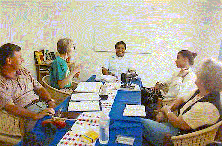Imagine a language course that starts off with the instructor giving a monologue that lasts all of sixty minutes, delivered almost entirely in Spanish. What our teacher, Hugo, gave us on that first day was a rundown, delivered at a normal conversational pace, on what we could expect in the next month. There were very few English words used, other than those we obviously didn’t understand. The only saving grace for us was that Hugo repeated his message constantly in several different ways.
 It was quite riveting and my three classmates and I listened intently. My wife, Cecilia, and I had signed up for a month of Spanish tuition at the Instituto de Comunicación y Cultura in Oaxaca. Our classmates were Maria and Roberto, a retired couple from Chicago, who travelled a great deal in Central and South America every winter and wanted to improve their Spanish. Classes would be three hours each day.
It was quite riveting and my three classmates and I listened intently. My wife, Cecilia, and I had signed up for a month of Spanish tuition at the Instituto de Comunicación y Cultura in Oaxaca. Our classmates were Maria and Roberto, a retired couple from Chicago, who travelled a great deal in Central and South America every winter and wanted to improve their Spanish. Classes would be three hours each day.
Listen, listen, listen….
What Hugo told us in his monologue, over and over, was as follows. Do lots of listening. Listen to the radio. And listen to as much everyday conversation as you can. The Instituto arranged for us to spend the month living with a Mexican family, about ten minutes’ walk from school. I don’t know if it was by accident or by intent, but no one in the household spoke a word of English. Needless to say, we heard lots of Spanish. We had a comfortable room with en suite bathroom and the use of the kitchen, although all we ever made there was breakfast and snacks. It was a big household with children, sisters, brothers, grandmothers, and a maid who was a wonderful gossip. It was pretty close to total immersion.
Don’t watch tv, Hugo told us, in his lengthy introduction. You’ll simply end up watching, not listening. You’ll learn to become fluent in body language, rather than spoken language. Listening to songs won’t help, either, because they’re usually expressed in a poetic language of their own which is not conversational. He himself was learning French and he had started by listening to French radio broadcasts on short wave and to Edith Piaf records (thus refuting his own advice about listening to songs). Radio forced the mind to understand, he said. Commercials and news were best of all because they concentrated the mind and forced the listening process.
Just as an additional little hint, which someone passed on to us later, the best way to make use of radio is to listen to a news broadcast or, even better, a serious discussion and to tape it. That way you can replay it any number of times and you have a much better chance to analyze it and pick up more words and expressions.
Concentrate on what language is really about — you
Concentrate mainly on the past tense, said Hugo, because it covers most conversation – people talking about what they did, or thought or said. When you learn to conjugate verbs concentrate on the first person in the past tense: I went, I made, I ate, I saw, etc., etc., until you find it comes automatically. Hardly anyone talks in the present tense, so spend less time on that. At least don’t waste a lot of time practising it. Spend the most time on the stuff that you are most likely to use.
Learn to use the irregular verbs first rather than last. It’s easier when you go to learn the regular verbs.
It’s not really necessary, for conversational purposes, to learn the future tenses. If you use voy, va, vamos, etc. (I’m going to, he’s going to; we’re going to…) that will take care of quite a few future situations. However, it is necessary to learn other tenses more completely in order to read newspapers and magazines.
Books weren’t going to help us either, he said. No one could really expect to learn to converse from reading a book. Rather, we were going to learn the way children learned, by taking in language on a broad front, the way it is actually spoken. Children don’t really learn to speak by any kind of structured method. They just hear spoken words and start using them and adapting them to their own uses.
There’s no way you’ll ever learn to converse by having to think consciously of all the things you need to know and want to say. And don’t waste time waiting for the perfect moment when you’ll be able to use these neat examples of grammar and conjugation that you’ve learned. Rather, plunge right in and communicate and risk being corrected. Make mistakes. Don’t be afraid. Just use the language.
It was interesting to see how intently we were all stretched forward, hanging on to every word that Hugo said — almost all of it in Spanish. It required some effort to keep concentrated for that long. For me, at least, it was my first exercise in listening hard for such a long period of time. The good part, of course, was that I understood what he was saying. Not every word — but at least I got the general drift. The repetition of almost every statement, over and over, certainly helped.
Playing games with language
During the rest of that first week we interviewed each other. We described each other. We played games where an object was hidden in the room and each of us had to find it by asking questions only in Spanish. We translated texts and we discussed idioms and slang expressions. We spent a lot of time with pictures, describing the things people were doing and answering true or false questions about each photo. The wide variety of subject matter, often chosen at random from magazine pages, made us stretch to find the words to cover the situations. One day Hugo read Little Red Riding Hood to us and we translated it as he went along. Another day he played a Madonna song with both Spanish and English lyrics and we spent some time analyzing the differences
In the ensuing weeks we also had lessons on the kinds of topics you would expect: verb conjugations; verbos pleonasticos, the two past tenses; the difference between para and por; and ser and estar; reflexives, prepositions and a bunch of idioms, expressions, short cuts and other grammatical topics. As the days went by the instruction was given almost completely in Spanish. I was amused around the third week to see that I was even writing my notes in Spanish.
Luego ti aviso
One day Hugo wrote on the blackboard the phrase: Luego ti aviso, (I’ll tell you later). “Hold it,” I said. To me that reads as: ‘Later you I’ll tell.’ In English that’s completely backwards. And it’s typical of thousands of Spanish sentences. Now what are we supposed to do? Are we meant to turn every sentence around in order to be able to understand it? It’ll take us forever to learn conversation if we have to do that.”
“Precisely,” said Hugo, “you’ll never learn Spanish if you do. It’s much easier to learn Spanish the way people speak it without being so analytical. Learn to say simple things in Spanish and not get too involved in complex sentence structure. After all, you’re in a conversation class. We aren’t teaching grammar — only the grammar you need. You aren’t taking a university course where there’s an exam at the end of the term. This process is designed to get you talking in Spanish — not perfectly, but at least understandably. Don’t analyze everything. The key things are to listen, repeat and involve yourself in conversational exchanges. You’ll learn far more that way than you will by taking Spanish apart, sentence by sentence. Does that make sense?”
“Luego ti aviso, Hugo,” I told him.
Listening at a conversational pace.
Another of Hugo’s techniques was to read to us at a fairly brisk pace, making us concentrate on large chunks of information at a time. Also, we practised making short statements in Spanish, running the words together, as Spanish speakers do, to get us out of that plodding, one-word-at-a-time approach that we gringos use when we speak Spanish. Que está became questá. ¿Como está? became ¿comestá? A sentence like, “Y aquel edificio alli, ¿qué es?” became, “Yaquel edificio alli, ¿ques?” When we protested, Hugo was fond of quoting all we English speakers who say things like: Whatchagonnado? or Wherjaputit? Hugo, we soon discovered, collected English idioms and delighted in playing them back to us when it suited him.
We had several discussions about idioms. We often complained about expressions that made no sense to us, such as me vale (it’s not important to me) or hay que caminar (let’s take a walk). Hugo, however, would simple point out to us that English expressions, such as my nose is running; not at all; tongue in cheek; the pits; up the wall; out of my tree; cool; awesome; etc. etc. don’t make a lick of sense to a Spanish speaker. His collection was endless. I was happy to pass on to him one of my favorites concerning the Spanish speaker who remarked about English: “What can you do with a language where you chop a tree down and then you chop it up!”
That’s language for you. Learn to live with it.
I must say, however, despite lots of setbacks, that the process works — slowly. Our ears are becoming more attuned to everyday speech and we hear more things than we did. My wife is a better listener than me and she definitely learned to converse faster. I’m a better reader and, according to the school, good readers take a longer time to learn conversation because they’re too analytical. After my month in Oaxaca I reluctantly agree.
¿Que hizo usted ayer?
One of the daily exercises was for each of us to answer the question: ¿Qué hizo usted ayer? (What did you do yesterday?) It wasn’t a time to relax while the others were talking, however, because we were all quizzed on what the other people said. “How many beers did Beto have with dinner last night?” or “What did Maria have for dessert?” And, naturally, after all that urging to listen we didn’t want to be accused of not having paid attention to each other. Another good homework exercise was to actually write out what you were going to say. When the time came to say it, throw the script away.
All in all, my wife and I found it one of the most interesting months we ever spent. There isn’t a more pleasant city than Oaxaca in which to be a student. As we were there for a month, there was no rush to visit the tourist spots. Instead, we had time to lounge in the cafes around Oaxaca’s wonderful zócalo or places like Cafe Gecko where other students and tutors gathered every morning to converse or do their homework.
There are several language schools in Oaxaca, as there are in other Mexican cities. We picked the Instituto, in our usual casual fashion on a previous visit to the city, probably because we liked their literature and what they said about themselves. Also, they’d been around for ten years. We weren’t disappointed with our choice. The teachers were good and the administration efficient. They also found us excellent accommodation. We expect to go back to Oaxaca for another month sometime during the next year. When we do, we’ll go to the same school, ask for the same teacher and also ask to stay with the same family. What more can we say?
Are we fluent in Spanish now? No, we certainly aren’t. All we can say is that we speak and understand Spanish better and we feel more encouraged to keep on studying. Before we went to the school we were somewhat depressed about the whole subject. Three years in Mexico and we still can’t carry on a proper conversation! Now we feel rejuvenated and ready to go back to work. We’re even beginning to feel more at ease with those grammatical constructions gringos find so troublesome. I’m referring to sentences like: ¿Me le presta….? (Will you lend me…?). Or, ¿Me hace un favor? (Will you do me a favor?). Or Nos vemos (See you later). They’re not any easier. Indeed, there are still days when I feel I’m trying to break the German Enigma code. But they’re starting to make more sense.
Now if only we could start working them into our next conversation with the maid or the gardener….
Current prices at the Instituto are $350 U.S. for a month or $100 per week. There’s a 10% discount for folks over 60. Accommodation prices vary, depending on what you require. Our room for two, with private bathroom and kitchen privileges cost $300 for the month. We thought it was a great bargain. Also, there are many wonderful restaurants in the city where two can dine for less than $10.
Instituto de Comunicación y Cultura, A.C. is located at 307 M. Alcalá Street, Oaxaca, Oaxaca 68000, Mexico.
Tel\Fax: 951 516-3443. Country code from the U.S. and Canada is 52.


